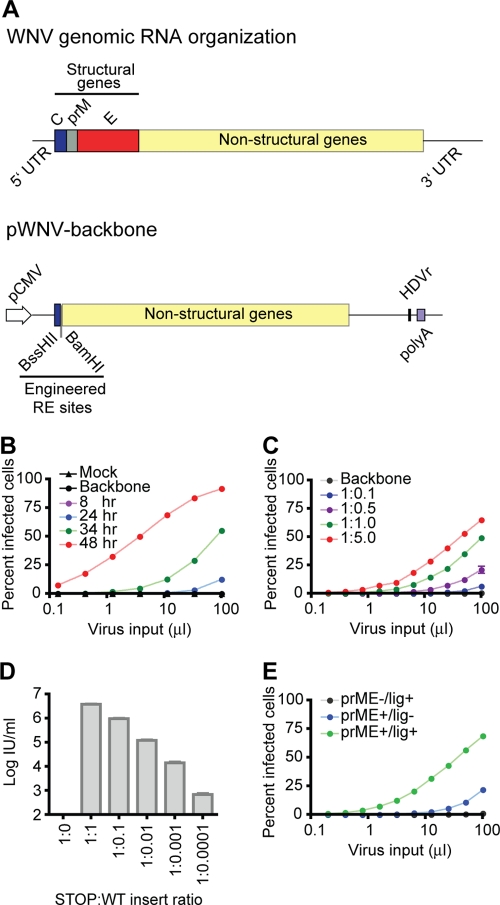Fig 1.
A rapid and simple method for the production of infectious WNV. (A) Schematics of the pWNV-backbone construct. Plasmid pWNV-backbone was constructed by a modification of a two-plasmid infectious clone system of WNV NY99 (4). A truncated form of the viral genome was placed under the transcriptional control of the CMV immediate-early promoter/enhancer (pCMV). In this construct, the majority of the structural genes have been deleted, along with a small portion of the amino terminus of NS1 (nucleotides 195 to 2514 of NY99). This deleted region was flanked by unique BssHII and BamHI restriction sites introduced into the vector via synonymous mutations. The ribozyme from HDV and the poly(A) sequence signal from SV40 were placed downstream of the viral 3′ UTR to ensure the correct processing of the 3′ terminus of the genome and to protect the RNA from degradation. (B) Kinetics of WNV production using the pWNV-backbone system. A DNA fragment carrying WT structural genes was generated by PCR, ligated into pWNV-backbone, and transfected into HEK-293T cells. Virus-containing supernatants were harvested at the indicated times posttransfection. Transfections of ligation reaction mixtures lacking the structural gene fragment (backbone) or with no DNA (mock) were included as controls. The virus titer was determined by infecting Raji cells expressing the attachment factor DC-SIGNR with serial 2-fold dilutions of supernatant. Infection was scored as a function of the percentage of cells expressing viral E proteins. Data are representative of four independent experiments. (C) Effect of varying the ratio of backbone to insert (by mass) in the ligation reaction mixture. The virus titer was determined as described above. Data are representative of two independent experiments. (D) The sensitivity of the ligation-transfection approach for capturing functional structural gene fragments was evaluated by varying the ratio of the WT structural gene sequence to a nonviable mutant in the ligation reaction mixture. The ratios of the two fragments in the ligation reaction mixture are indicated, where STOP refers to the sequence obtained from pWNV-complement-5′. Virus-containing supernatants were obtained at 120 h posttransfection, and titers were determined as described above (limit of detection of 102 IU/ml). The data are representative of two independent experiments; error bars represent titer results from three dilutions of virus. Similar results were obtained when plasmids harboring WT structural gene sequences and a variant shown previously to confer sensitivity to a neutralizing antibody (57) were mixed; virus with a resistant phenotype was isolated in the presence of MAb E16 even when only 1 in 10,000 structural gene molecules encoded a resistant genotype (data not shown). (E) The production of virus using the pWNV-backbone system is not strictly ligase dependent. Ligation reaction mixtures were assembled in the presence or absence of ligase enzyme, incubated at 16°C overnight, and transfected into cells. Virus was harvested, and titers were determined at 48 h posttransfection. Data are representative of two independent experiments.

